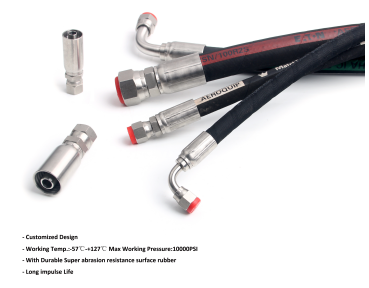To ensure the proper and safe use of hydraulic hose assemblies, follow these guidelines:
Select the Correct Assembly: Choose a hydraulic hose assembly that meets the specific requirements of your application, including pressure rating, temperature range, fluid compatibility, and environmental conditions. Refer to manufacturer specifications and industry standards for the appropriate selection.
Inspect the Assembly: Before installation, inspect the hose assembly for any signs of damage, such as cuts, abrasions, bulges, or leaks. Check the fittings for proper threading, cracks, or deformations. Replace any defective components before proceeding.
Prepare the System: Clear the hydraulic system of any residual pressure and ensure it is shut off. Clean the connection points on the system components and the hose assembly to eliminate dirt, debris, and contaminants that can jeopardize the connection and cause damage.
Install the Assembly: Align the fittings with the connection points and push the hose onto the fitting until it reaches the specified insertion length. For one-piece fittings, a simple push-on installation is usually sufficient. For two-piece fittings, follow the manufacturer’s instructions for assembly, which may involve crimping or swaging the fitting onto the hose.
Secure the Assembly: Secure the hose assembly using appropriate clamps or brackets to prevent excessive movement or vibration, which can lead to premature wear or damage. Make sure the assembly has proper clearance and does not contact sharp edges or other components that could cause abrasion or puncture.
Conduct Operational Checks: Once installed, carefully inspect the entire hose assembly for any signs of leakage or abnormal behavior, such as fluid seepage, pressure drops, or unusual vibrations. Test the system under normal operating conditions to verify proper functioning and performance.

Monitor and Maintain: Regularly monitor the condition of the hydraulic hose assembly, checking for wear, degradation, or any potential issues. Follow recommended maintenance practices, including periodic inspections, fluid sampling, and replacement of components based on manufacturer guidelines or industry standards.
Remember, proper training and understanding of hydraulic systems are essential for using hydraulic hose assemblies correctly. When in doubt, consult with a professional or refer to the manufacturer’s instructions and guidelines for your specific assembly.
Post time: Jan-04-2024
